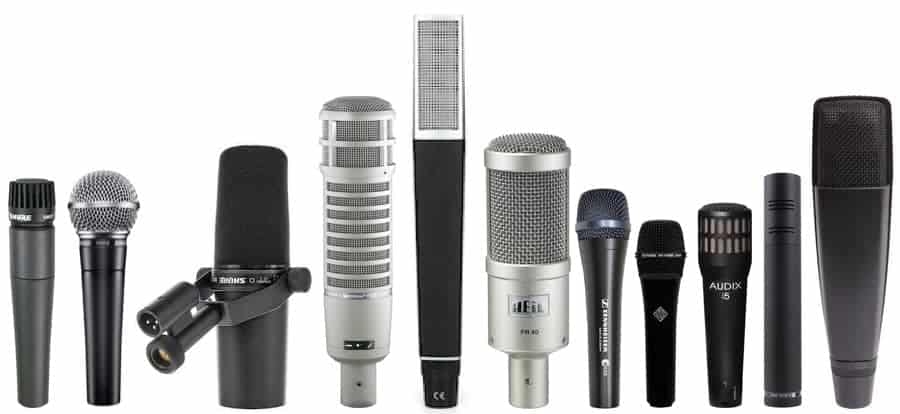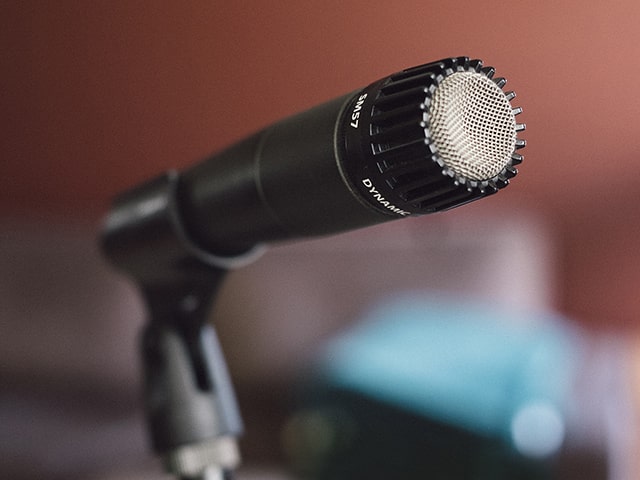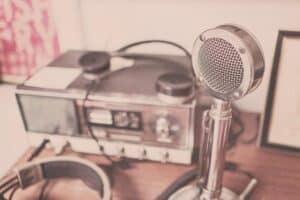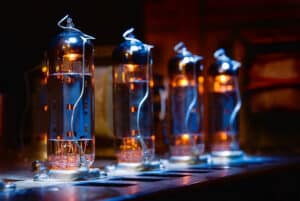A microphone is much more than just a means of amplifying the voice through a speaker. If you are looking for a microphone, you will quickly realize that there are different types of microphones, each with unique characteristics depending on the use of the microphone. That said, all microphones are designed with the same purpose in mind: to convert sound pressure variations into electrical signals.
In this article, we will explain the difference between two main types of microphones: dynamic and condenser.

How does a dynamic microphone work? 🤔
To understand how a microphone works, it is important to know the different parts that make up the microphone (or its anatomy). A dynamic microphone can be divided into three parts:
- The transducer element characterized by the physical principle involved in the energy transformation
- The microphone case plays an important role in one of the qualities of a microphone ( especially its directivity)
- The AC voltage generator with an internal resistor.

A dynamic microphone, as its name suggests, works on the same principle as a bicycle dynamo.
Like this dynamo, a dynamic microphone has a moving copper coil that is located in a magnetic field around a magnet. The movement of the coil in response to the sound wave produces a current. Instead of a bicycle wheel, a dynamic microphone has a membrane that moves according to the acoustic pressure produced by a sound wave.
The dynamic microphone consists of a very thin diaphragm. It is very light and is attached to the coil. The coil is made of copper wires with a total length of 2 to 4 meters. It must be as light as possible, because it will move in the air gap of a fixed permanent magnet with an induction of about 1 Tesla. The operating principle of a dynamic moving-coil microphone is based on Faraday’s law. In simple terms, the variation of magnetic flux through a closed circuit causes an electric current to appear, called the induced current.
The diaphragm will start to vibrate in front of a sound source. The coil which is mechanically attached to it will also move. It is this back and forth movement that will generate an electric current within the coil. The output level is low, but can be amplified up to a certain level without problem. To do this, we can use a pre-amp that can be found in the input circuits of a mixing desk for example.
Dimensions of the capsule of an Electrodynamic Microphone 🎤

The uninitiated may think that dynamic microphones generate noise by themselves because of their built-in active circuitry. But, all circuits have an electrical circuit that will produce noise. Higher resistors produce higher noise levels. In addition, the impact of air molecules on the microphone diaphragm will generate noise.
A large diaphragm is therefore a major advantage, because the sound is generated from the impact of air molecules. The larger the diaphragm, the better the result. Dynamic microphones are generally available in omnidirectional and cardioid versions. For this type of microphone, it’s not possible to use more than one diaphragm. Therefore, each model is normally designed to offer only one type of directional response.
Bandwidth to Response Curve of a Dynamic Microphone 📈
The bandwidth of a microphone is the ability of a microphone to reproduce the frequencies it picks up. The bandwidth of dynamic microphones is much smaller than that of a condenser microphone. In practice, microphone manufacturers will reduce the bandwidth to adapt them to certain types of recording. In the case of a dynamic microphone, this bandwidth will be between 80 Hz and 15,000 Hz. This represents the frequencies of the voice.
The response curve will correspond to the microphone’s characteristics. In other words, it installs the response of the different frequencies included in its bandwidth. It is presented in the form of a diagram which shows the peaks and troughs according to the frequencies picked up by the microphone. In general, the response curve of a dynamic microphone is fairly linear over a frequency range of 30 Hz to 10 kHz.


Phantom Power and Dynamic Microphone 👻
Usually a phantom power supply is used to activate the condenser of a condenser microphone and to power the small built-in amplifier. Some dynamic microphones have such an amplifier. In this case, we speak of an active microphone. Passive dynamic microphones do not require an external power supply. However, if they are supplied with power, they cannot be damaged. There is, however, one condition: you must use the correct cable.
The General Characteristics of a Dynamic Microphone 🤙
A dynamic microphone is omnidirectional. It has a fairly low sensitivity and will therefore require the use of a pre-amplifier. It can handle sound pressure levels of up to about 180 dB SPL. Its response curve is more or less linear over a frequency range of 30 Hz to 10 kHz. It is, however, much less accurate than the condenser microphone.
The dynamic microphone is less sensitive to wind than to vibration. This is due to the high inertia of the microphone, caused by the mass of the coil. Manual operation may therefore be difficult unless the microphone is equipped with a shock filter. Otherwise, the use of a pole or tripod is recommended. In addition, it is a stable and very robust microphone. It is not very sensitive to moisture, which makes it the ultimate weapon for external use.

Inside a condenser microphone there is a small, thin membrane and a back plate. Between these two components, an electric field is created with the help of a battery or phantom power (supplied by a mixer, for example, via the microphone cable).
This building is called a capacitor. It is an electronic component able to storing energy in the form of an electrostatic field. The voltage level depends on the distance between the membrane and the back plate. As the membrane is very thin, it moves easily. If the air vibration moves it in the direction of the back plate, the output level of the microphone is positive. If the diaphragm moves in the opposite direction, the polarity is negative.

When do you use a Dynamic Microphone? 🧐

There are no rules for choosing a studio microphone. It all depends on the sound you want to obtain. This is the criterion for choosing a microphone.
However, dynamic microphones are able to handle very high sound volumes. This is why they are used for recording a bass drum or a snare drum. They can also be used for recording wind instruments such as saxophone, trumpet or clarinet. They are also the ideal recording equipment to pick up high volume guitar amps. They can easily be used on stage or in a recording studio.
They can also be used for vocal recording. The sound will not be as detailed as when used on an instrument, but it will still be acceptable. However, if you are recording metal or rock music, the result will surprise you.
However, as with ribbon microphones, the output level of dynamic microphones is quite low. They therefore require the use of a good amplifier. In some cases, the microphone requires a large gain to function properly.
On the market, you can see dynamic microphones that need about 60 dB of gain to achieve optimal results. This is higher than what is usually found on a mixer and on entry-level and mid-range audio interfaces.
In this case, it is recommended to use a Cloudlifter. This is a preamp with a particularly powerful circuit that can add up to +25 dB to your signal. With this equipment, you will obtain an exceptional sound quality. It goes without saying that this is not an essential piece of equipment for all dynamic microphones.
To improve the sound quality, you can also use an anti-pop filter, or a windscreen to limit plosives.
The advantages and disadvantages of a Dynamic Microphone 👊
Dynamic microphones have many advantages over their competitors. They have an exceptional quality/price ratio. Not only are they very robust microphones, but they are also relatively inexpensive. Its resistance gives it a certain versatility. Indeed, this type of microphone will always find a place whether on stage or in the studio. They can also handle high sound pressure levels.
However, they also have some disadvantages. One of these is the sensitivity of the microphone. The coil, which has a fairly large mass, is attached to the diaphragm. The movement of the diaphragm is limited by the weight of the coil. This will result in a loss of sensitivity, especially in the high frequencies. Generally, a dynamic microphone is designed to operate effectively up to 16 kHz. Above this frequency, the sensitivity of the microphone will drop considerably.

Thanks to technological advances, new materials have been used in the design of dynamic microphones. One example is the use of neodymium for the magnetic structure. It provides a much stronger magnetic field. It also allows the use of a much smaller coil. This will then allow the diaphragm to move faster in the high frequencies. This has allowed some manufacturers to provide their microphones with a frequency response of up to 20 kHz.
The output level of the dynamic microphone is also among its weaknesses. Dynamic microphones require a lot of amplification. If the sounds to be picked up are loud and close to the microphone, this is not a problem. However, if the sounds are weak and/or distant, they will require amplification. The result will be too loud. This is one of the reasons why dynamic microphones are not used for recording instruments such as the acoustic guitar.
How does a condenser microphone work? 🤔
Unlike a dynamic microphone, the condenser or condenser microphone doesn’t involve a moving coil device. A thin, extremely light disk forms the diaphragm of the condenser microphone. It is made of either titanium metal, aluminum alloy or mylar. In other cases, a specially treated, conductive polyester is used.
This membrane is floating and is one of the armatures of a capacitor. It is placed at a distance of 20 microns from the fixed rear armature. These two plates form the whole of the capacitor’s armature. The air between the plates will act as a dielectric. The distance between the two plates is variable. It is the pressure variations caused by the sound source that will make this distance vary. It will be translated into an electrical signal.
This type of microphone needs an external power supply to function properly. It is a 48 volt phantom power supply that will play this role. An audio cable will then carry the generated current.

It’ s important to note that this doesn’t interfere with the transmission and the use of the audio signal. Indeed, the power supply will polarize the plates of the capacitor using a direct voltage of 48 Volts to charge itself. The mobile diaphragm is then subjected to the action of an acoustic wave.
The distance between the plates will also change. The capacitance of the capacitor will change but the charge of the capacitor will remain constant. The guarantee of a high sensitivity is the distance between the diaphragm and the fixed armature. It should be the minimum possible. For an exceptional result, the diaphragm should not only be light, but also as taut as possible.
Condenser microphones have a very high sensitivity. Indeed, the sensitivity is between 2 and 10 mV/Pa or a sensitivity level of -54 and 40 dB. Thanks to its design, it also has an excellent frequency response curve.
This type of microphone is delicate and very sensitive to humidity. In addition, it requires a power supply (Phantom) to produce the bias voltage for the condenser. It should also be noted that, as a condenser or condenser microphone, a condenser microphone tends to attract dust.
One of the advantages of the microphone is that it can be made very small. This is why most lavalier microphones are condenser microphones. In addition, they are not very sensitive to shocks and external magnetic fields. One of the greatest advantages is their polar characteristics, which are close to the ideal curves.
The advantages of a condenser microphone ✅
The diaphragm of a condenser microphone is much thinner than that of a dynamic microphone. In addition, it’ s not connected to a coil, which allows it to move more easily. As a result, the frequency response of a condenser microphone is wider than that of a dynamic microphone.
It delivers a very detailed and natural sound, which makes it perfectly suited for acoustic instruments and jazz-oriented singing. Condenser microphones come in a variety of versions and there are some very compact models. Most tie microphones and headset microphones (also with a very discreet design) belong to the condenser family.
The Different Types of Condenser Microphones 🎤
There are two main types of condenser microphones on the market:
- A condenser microphone, which requires the use of an external power supply;
- An electret condenser microphone, which is a recent innovation.
👉The externally polarized condenser microphone:
This is a classic condenser microphone, since it requires 48 volts of phantom power to operate.
👉 An electret condenser microphone:
An electret is a dielectric material in which permanent polarization is achieved. The use of an electret in a condenser or condenser microphone allows the external polarization source (phantom power) to be abandoned. There are two possible configurations for this:
- Either the electret is placed on the fixed electrode,
- Or it’ s deposited on the metal diaphragm.
Commonly known as a wireless microphone, its behavior is similar to that of the conventional condenser microphone. However, electret microphones require a continuous power supply to operate. Since they don’t require an external power supply, this technology is used for many applications.
Examples include lavalier microphones, or microphones for cell phones. It can also be found in microphones combined with a headset attached to the end of a rod. This same technology is also used in stage microphones attached to the head. In other words, this technology makes it possible to have small, very effective microphones.
The best electret condenser microphones are known for their exceptional quality. They deliver stunning sound quality and are frequently used for broadcasting. They are also used for recording and sound reinforcement.
Thanks to its small diaphragm, the microphone picks up almost no handling, background or mechanical noise. In most cases, this type of microphone has a cardioid or hypercardioid pickup pattern.
It also has two additional advantages over other microphones: their lightness and their size. Indeed, they can be very small. In addition, its characteristics are particularly suitable for a wireless microphone, and miniature microphones of all kinds.

Misconceptions about Condenser Microphones 👏
- Condenser microphones are much more fragile than dynamic microphones: not necessarily ❌
Currently, there are several types of microphones that are specifically designed for studio use. Just because a microphone is intended for studio use doesn’t mean it is necessarily fragile. It all depends on the design and choice of building materials. Some good quality microphones (e.g., Neumann or Shure) can withstand frequent and repetitive handling.
- Condenser microphones always need phantom power: partly true ✅
If your microphone doesn’t produce sound, it may need an external power supply. However, there is what is called the electret condenser microphone. This type of microphone uses either a phantom power supply or a battery. It is often used as a wireless microphone.
- Condenser microphones are very sensitive to feedback: not necessarily true ❌
It is a matter of choosing the right microphone for the right application. For example, using a condenser microphone for remote recording will result in low frequency feedback. In this case, the microphone will be misapplied unless a low-pass/high-pass is used.
- Condenser microphones cannot handle high sound pressure: False ❌
Condenser microphones can usually handle very high sound pressure levels. The real question is the capacity of the preamp used.
- Using a condenser microphone is much more expensive than using a dynamic microphone: sometimes true ✅
It all depends on your purpose. Of course, dynamic microphones are less expensive. There are also some very powerful ones. But in the end, what about the quality of your production? Always keep in mind that each microphone has its own specific application.


A feedback on the use of Condenser Microphones 🤙
Microphones are part of our daily lives. The current market offers several types of microphones, including the condenser or condenser microphone. This is a versatile studio microphone that offers exceptional sound reproduction. Condenser microphones offer very good audio quality. They are professional microphones that can be used in a variety of polar patterns. Some have a fixed cardioid pattern. For more versatility, other microphones have a switchable option from cardioid to bidirectional or even omnidirectional.
In general, the sound produced by a condenser microphone is very popular because of the proximity effect. It is a warm and natural sound. This is mainly due to its linear frequency response. To add a touch of originality, manufacturers add a small, well-designed hump at a specific point. The aim is to control the highs and to obtain a much warmer bass for example. Condenser microphones are compatible with almost all audio interfaces and mixers. They can be used as a microphone with the addition of a windscreen, or a pop filter. They are primarily used to protect the microphone and to control pop. Engineers also use them for recording various instruments such as acoustic guitar, piano, clarinet, percussion…
One of the most popular features of condenser microphones is their high sensitivity. This is a result of the design of the microphone. If you can hear the chirping of birds in your recordings, the microphone can also hear them. This is one of the reasons why it is mainly used in an acoustically treated room. But this sensitivity can also highlight all the sounds of the mouth and lips. All vibrations will be picked up by the microphone. To compensate for this, you can use a pop filter, a microphone stand or a microphone pole
This is an essential piece of recording equipment for studio recording. If you meet a recording engineer, ask if he or she has a condenser microphone. The answer will be a definite yes. If you go to a professional recording studio, they will also have a condenser microphone. All this to say that any self-respecting professional knows the value of a condenser microphone.
Is a condenser microphone better than a dynamic microphone ❓
No, both types of mics have their advantages and disadvantages.
Condenser mics are often used to record acoustic guitars or drums and produce a natural, bright sound. In addition, they are suitable for recording choirs and orchestras.
Dynamic mics, on the other hand, can handle high volumes of sound and are ideal for recording guitar amps, wind instruments, toms or snare drums. In addition, they are often used for close miking.
Which one is the best microphone for singing ❓
Generally, dynamic microphones are used to record the voice on stage and condenser microphones for the studio.
Compared to condenser microphones, dynamic microphones are less fragile and less susceptible to feedback and are therefore better suited for stage performances.
cheap capacitor that is sensitive to high frequencies seems at first sight to be a good choice but is in fact difficult or impossible to mix.











